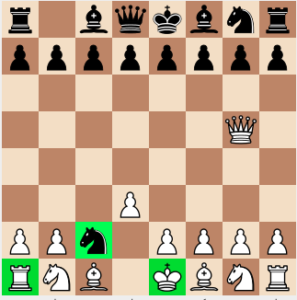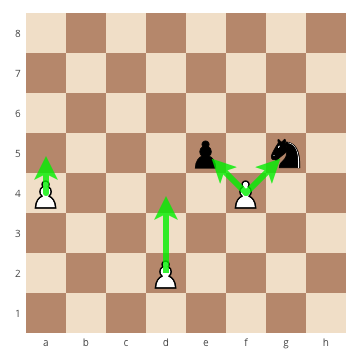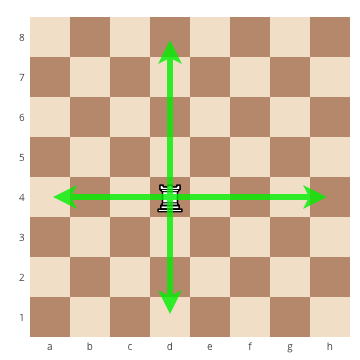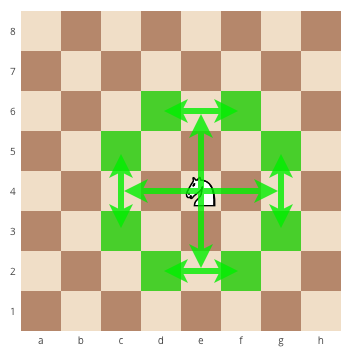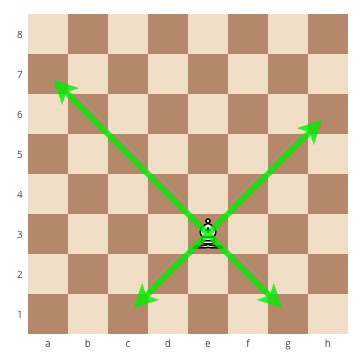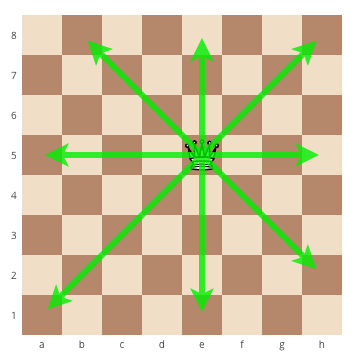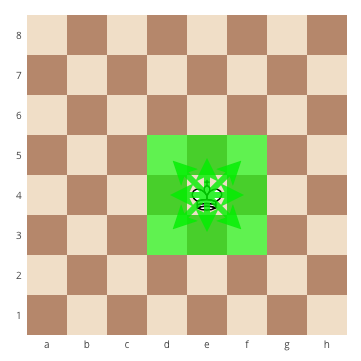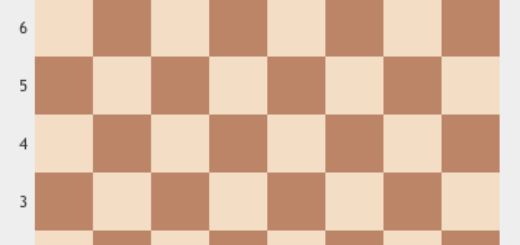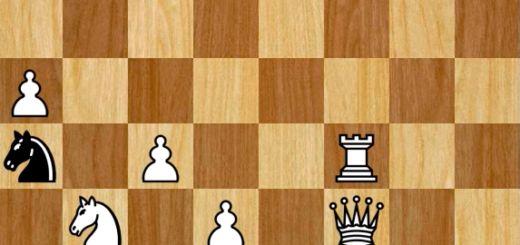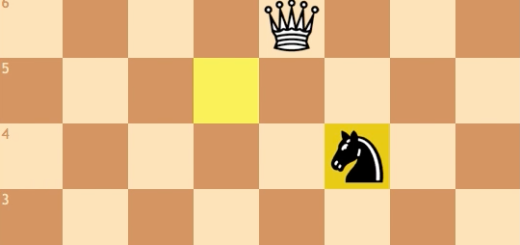How To Move The Chess Pieces Correctly
How To Move The Chess Pieces Correctly
Learning how to move the chess pieces correctly is one of the biggest starting point for new chess players.
For those new to the game of chess, there’s a lot to be learned, and let’s first make sure you’re covered the previous bases. First, you must learn how to correctly set up a chessboard. Once you can set up a chessboard, learning how to move the chess game pieces correctly is a critical step in your chess game development. (Along with learning how to play chess of course).
Compared to other games, chess can seem like a lot to learn at first, especially when it comes to correctly moving the chess pieces around the chessboard. The good news is, once you master how to correctly move the chess pieces, it will become second nature when you play.
Today, you will learn the correct ways to move the chess pieces in a clear and simple manner. (We also have a more in-depth focus posted on Learn Chess 101 for each chess game piece) Let’s get started.
How To Move The Chess Game Pieces Correctly 101
How To Correctly Move The Pawns In Chess
 With each player beginning with 8 pawns, they are the most numerous pieces in chess. The pawns are one of the simplest chess piece to move in the game.
With each player beginning with 8 pawns, they are the most numerous pieces in chess. The pawns are one of the simplest chess piece to move in the game.
Moving
The pawns can only be moved forward, one space at a time. The exception to this rule is on the first move for a pawn, in which a pawn can be moved either one or two spaces forward.
While the pawns may seem like a very basic piece, always remember to value them. If your pawn is moved to the opposite end of the chessboard, it can be promoted to a queen.
The pawns can also be critical in capturing your opponent’s high value pieces. When moving the pawns, always be sure to keep them protected, either by protecting your pawns with other pawns, or with your high ranking chess pieces.
Capturing
The pawn is the only piece that captures differently than how it moves. Pawns capture one space forward on the diagonal, as shown in the diagram above. (A more in-depth guide on pawns available here).
How To Correctly Move The Rooks In Chess
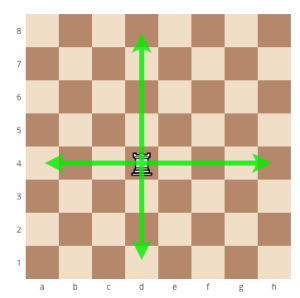 The Rooks (also known as the Castle) are moved across the chessboard, as many spaces are available. This means the Rooks can be moved either forward, backward or side to side.
The Rooks (also known as the Castle) are moved across the chessboard, as many spaces are available. This means the Rooks can be moved either forward, backward or side to side.
The Rooks cannot be moved diagonal or move through/over any chess piece (no chess piece can move through chess pieces). (A more in-depth guide on Rooks available here).
Because of the rook’s wide range of movement, it makes them one of the most powerful pieces on the chessboard, the queen being the most powerful. Always make sure your rooks are protected. Capturing just one of your opponent’s Rook’s will give you a great advantage in the game.
Lastly, when the game is coming to an end, if you have both rook’s, it’s very simple to checkmate your opponent’s King.
How To Correctly Move The Knights In Chess
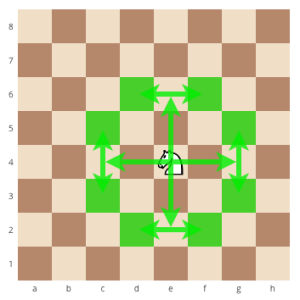 The Knights are moved one space forward and two to the side, known as the “L” shape. This allows the knights to move around players and makes them a highly valuable chess piece on the board. (A more in-depth guide on Knights available here).
The Knights are moved one space forward and two to the side, known as the “L” shape. This allows the knights to move around players and makes them a highly valuable chess piece on the board. (A more in-depth guide on Knights available here).
The knights are also the only piece in chess that are able to actually move around chess pieces. Due to their wide L shape range of movement, it;s very common to be able to capture your opponent’s high ranking pieces with the knight, such as a queen or a rook.
The key is to place your opponent’s King in check with the knight, and then have your opponent’s queen or rook in the same range of capture. Your opponent will be forced to move their King, and then have their rook or queen captured by your knight on the following move. (Be sure not to allow this to happen you.)
How To Correctly Move The Bishops In Chess
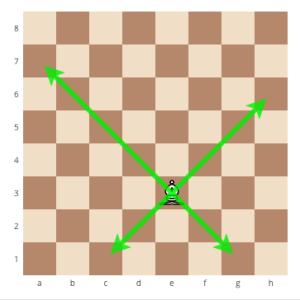 The bishops are moved diagonally, either forward or backwards, across the chessboard, as many spaces are available. The bishop cannot move side to side or directly forward or backward like the rook.
The bishops are moved diagonally, either forward or backwards, across the chessboard, as many spaces are available. The bishop cannot move side to side or directly forward or backward like the rook.
Like all chess pieces, the bishop cannot move past or through another chess piece. In the photo below, the bishop on the right cannot move to its right, as it is blocked by its own pawn. 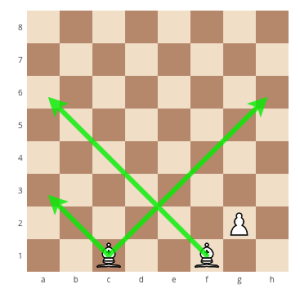
The bishops are a crucial piece in chess in that they have a very long range of attack, and many times, they’ll have a far range attack on the diagonal that your opponent (or you) may miss. Always be sure to keep an eye on your opponent’s bishops, and always be sure to have your own bishops in a position to have a wide range of capture across the chessboard.
(A more in-depth guide on bishops available here)
How To Correctly Move The Queen In Chess
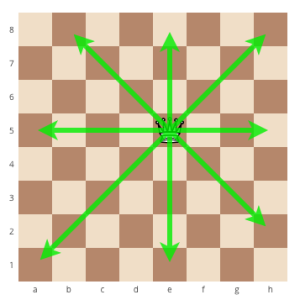 The queen is by far the most powerful piece in the game of chess.
The queen is by far the most powerful piece in the game of chess.
The queen is a combination of the rook and the bishop, being able to move both forward, backward, side to side, and diagonally, as many spaces as are available.
As you can see in the photo above, the queen can capture any of those opponents due to her wide range of movement. (A more in-depth guide on queens available here)
How To Correctly Move The King In Chess
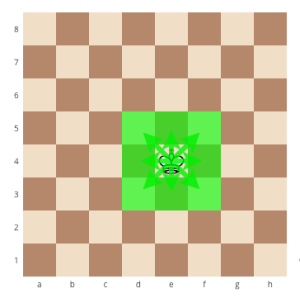 When it comes to how to move the chess pieces correctly, the King is one of the most simple chess pieces to move.
When it comes to how to move the chess pieces correctly, the King is one of the most simple chess pieces to move.
While the game revolves around the King, the King is not intended to be a major piece in terms of capturing opponent’s pieces.
The King has the freedom to move in any direction, but only one space at a time. This means the King can move forwards, backwards, side to side or diagonally. When the game is coming to an end, and there are only a few pieces left on the chessboard, both a few of your own and your opponent’s, that is when the King can become a crucial player.
The King may be used to protect 1 or 2 pawns moving across the chessboard to be promoted to a Queen.
The King may also be used to place your opponent in checkmate with 1 or 2 other pieces. Obviously, you can’t place your actual opponent in checkmate with the King, but the King can be used to prevent your opponent’s King from escaping checkmate. In the scenario below, without the light King in place, the queen would not have the dark King in checkmate.
(A more in-depth guide on Kings available here)
For more information on how to correctly move the chess pieces, such as capturing with the chess pieces, click on the specific links for each piece above.

